|
To Part Two
For those who sail and build boats, there is one true North,
one true thing, one true boat.
This is the story of how the boat found us. More than that, it
is a story about finding a friend in a most unexpected way, a
friend who changed our lives.
When searching for a boat to build the decision of which plans
one settles on is usually determined by long study, comparison
of one boat to another, one designer’s version to another.
Seldom is it determined by fate.
One afternoon a charming and polite, interesting and informative
e-mail arrived for me. I was stunned …it was from the world
renowned designer, John Welsford, of New Zealand. How had I had
the effrontery to bother someone so important, so famous with
my questions? Why had he answered me? In error I seemed to have
clicked my mouse on his e-mail address, hurriedly sending out
questions. I was apologetic for bothering him.
JohnW, in his usual down to earth way, I came to learn, replied,
“You seem to be in awe of my reputation, but I’m just
me. I swear when I drop something on my foot, smell bad if I don’t
shower and worry about the bills like everyone else. Just a guy
doing a job, mind you it’s one that I love.”
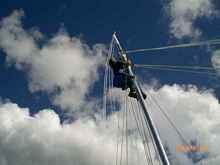 |
John not so down to earth |
How could I help being in awe? I loved his boats, loved his writing.
The photo on the book jacket was everything salty and nautical
you could wish for in a boat designer. The stories that accompanied
the designs of his boats carried you along on the journey, taking
you to waters you dreamed of sailing. JohnW was what I pictured
a designer of sailing craft to be, knowledgeable and spare in
replies to posts on forums, yet more learned and brilliant than
I could even imagine. Genius, talent, intellect.
“It’s interesting “ John said, “about
outsiders’ perception of us. I am something of a bibliophile,
as well as deeply in love with boats and boating. In my early
days I viewed both authors and boat designers as people who sat,
one on each side, very close to God. They were not human in the
same sense that I was. I could not imagine either having feet
that smelled or catching the flu. Now I find myself , with a couple
of books published and quite a few boats in the water , being
looked up to in the same way. It is an odd feeling.”
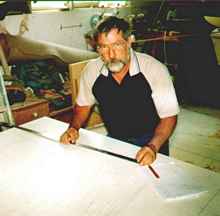 |
John at work |
What could I talk to him about? What could we have in common,
eight thousand miles away and a life time of difference? What
did I know about boats, about building or designing?
What could we talk about? A lot I found out. Conversations with
John Welsford have been both an education and a joy of learning.
Most importantly, I learned that finding a boat is not the issue.
. Find the designer and you will find the boat. But I am ahead
of the story. First I found a friend, then a designer and then
the boat. It was that simple.
Simple is one thing John Welsford is not.
“The time has come, the Walrus said, to talk of many things:
Of shoes….and ships….and sealing wax, Of cabbages
…and kings…and why the sea is boiling hot, and whether
pigs have wings.”
It took only a short time to lose my fear of the great designer.
We talked of everything… gardening, cooking and food, music,
dogs, cats, family, friends, travel, politics, America, New Zealand.
And yes, we had so much in common, miles and continents apart.
But boats, boats, boats and designing, we talked of that. And
the more we talked, the more I wanted a Welsford boat.
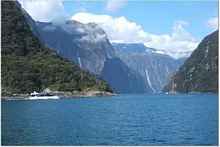 |
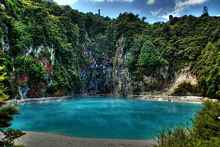 |
History plays into the design of all John’s boats. “I’ve
done a lot of research into historical precedents, the small coastal
fishing boats from around Cornwall and Devon in the mouth of the
English Channel. I obtained from museum files, local designers
and other sources sets of hull lines, analyzed them and worked
them into a set of statistics which in my view defined the characteristics
I was trying to achieve. I then designed Houdini to replicate
these characteristics using the numbers taken from research, adjusted
for scale effect, then sailed the boat to see how close I’d
been with my theories. Close! Very close, for a small open boat
Houdini is astonishingly seaworthy and comfortable in heavy weather
and amazingly quick in winds that you can’t even feel.”
“Swaggie and Sundowner are developments using the same
information and both of those are much more capable than you’d
expect from such small craft. By working out what numbers that
a boat that sails in a certain way and will perform in a certain
way, even before I begin to draw, then checking at every stage
that the drawings are consistent with those numbers, the design
result is within predicted parameters. I use English and French
boats as a model in most cases, they are the boats from which
many of the American boats’ ancestry is drawn.”
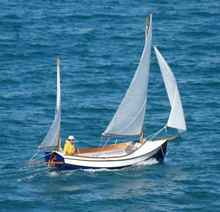 |
Salacia |
Classic, beautiful, designs based on historical reference and
place, designs influenced by the sailing and rowing craft of the
past, yet rooted in the present. Boats designed to the most seaworthy
of specifications, boats that would sail and perform in conditions
that exceed any we might encounter in our local waters,. Boats
that could take you to your dreams and back, even around the world.
I wanted one, I yearned to be building a Welsford. But we were
committed to building our Laguna, a boat we had made serious commitments
to take through adventures of her own. We do not back out of our
commitments. And JohnW understood and respected that. He is that
kind of man. Honoring commitments matters to him.
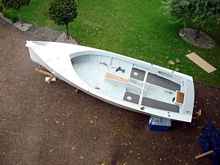 |
AWOL |
So, we talked about boats, the new AWOL he has designed for Dave
Perillo in New Zealand, the Saturday Night Special prototype for
the raids and coastal cruising, the new Pipkin dingy for the revised
edition of his book. We talked about the Houdini, the Walkabout
that I love, the Navigator and Pathfinder, we talked about Sundowner
and Charlie. How do you tell someone whose boats you love so much
that you cannot build one of their boats? That no matter how much
you love them, the boats are just not the boat you need to build?
Mike and I talked about it constantly, Mike saying “We just
don’t need another small boat.”
But John and I still talked of the new boats. “My friend
Blair, who has one of my Navigators is here for a few days. We
are building the prototype Saturday Night Special. The process
is slower than building from the full-sized patterns that we’ll
have later, so we began by scaling up all the panels and cutting
them out. By tonight we should have a hull, tomorrow the center
case, seat, bulkheads and keel all fitted. By Thursday, the insides
of the buoyancy tanks should be done and the decks on, and we
will be rigging her. If we had the sail, I’d say we could
sail her by Sunday.” Saturday Night Special is to be a fast
built boat, capable of being built on a beach for raids or coastal
cruising, built with locally obtained materials by those coming
from far away. Blair dreams of sailing in the TX 200, coming from
far away New Zealand, building the Saturday Night Special at Port
Mansfield, TX.
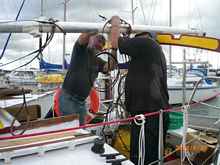 |
Rigging Resolution |
Blair is Captain Blair Cliffe, RN, RNZN M Eng, Extra master foreign
going, including bulk tankers, and has never built a boat before.
He wants to learn how. John is teaching him how to use the tools
and to build a glued plywood boat. “It’s looking good,
but this might not be the final iteration of the design, as some
of the shape would be a challenge to those who have not done this
before. Race teams would do the frames, rudder, dagger board and
as much other stuff as possible in advance, plus have full-sized
paper patterns to work with.” We compared and talked about
our own Laguna build, planning for a beach built Laguna and the
concepts of disposable boats to be used briefly for one event.
We had our Laguna already begun. She was becoming a much more
permanent boat than envisioned as we began. There was no changing
boats .
So John and I continued to talk about gardening, music, meals
and food. “Corn as high as an elephant’s eeeeeeeeye”,
or in the case of his neighbor, higher than the elephant itself,
the lack of flavor in commercially grown vegetables, digging dirt,
weeding, planting and the fact he had his fingers crossed that
his tomatoes didn’t get nipped by the last of New Zealand’s
cold weather. But always, we went back to the boats. Why did he
design? Why did he continue when he admitted that it was hard
to make a living doing so? Reality made John and other designers
like himself work at something else to make ends meet. Designing
wasn’t easy.
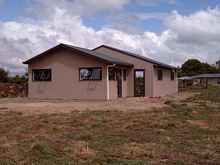 |
Shop and office |
“Why do I design? The passion is there. It can’t
be ignored and it’s a great vocation. There is nothing better
than seeing the joy and pleasure that people get from our creations.
I love being out on the water and seem to have a particular ability
to visualize a complex entity and translate that via drawings
into reality.
This enables me to share in a very direct way the joy and pleasure
that I get from boating. Hand in hand with that is the buzz I
get when I see people enjoying the results of my creativity.”
“ I had many heroes when I began, people who were the iconic
designers of that time. Today I get a sort of dazed bliss from
being included by them as an equal. It is a little like being
unexpectedly promoted to godhood. I enjoy doing something that
I admire in others, enjoy the pleasure that my creations give
others and enjoy doing something that I have unexpectedly found
that I am good at.”
Writing and words, beautiful words that paint evocative pictures
in your mind of wind, water, waves, rocks.
That’s another thing JohnW is good at. Are all boat designers
equally good with words or just well read?
Well, turns out John reads the unabridged dictionary for bedtime
reading, loves the meaning and use of words, taught creative writing
at college, along with maritime and automotive design at university.
A teacher and writer, a lover of words.
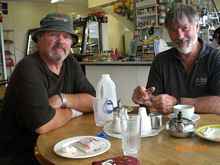 |
With Charlie |
“Some years ago I got handed a community college class
in creative writing. The previous tutor had been pretty dry, but
I am not into that. We did a novelette which was hilarious but
illustrated the methodology behind any successful writing. Each
group wrote a bio for a character, another worked up a town, another
a brief history of area, so on. Then we’d put all the elements
together, each night we’d work out where we were in plot,
each person would go away and write up their perception of it,
offering it the next class night.”
“They were all so serious when I arrived, that didn’t
last long. The whole bunch would be bouncing up and down in their
seats, yelling suggestions and breaking up laughing. Among the
few rules for the story were that it had to begin with “It
was a dark and stormy night” and at the end the butler had
to be the guilty party.”
“Like teaching marine design, the fastest way to learn
how to write, is teaching it.”
Writing. We talked about writing. “The Backyard Boat Builder”,
John’s book, continued with revisions and editing, more
additions as we corresponded. “Writing. I’m about
halfway through what I hope will be the last draft” Then
later, “Am working on a new design for the book, Pipkin,
the smallest measure of an English cask. Garth Battista wants
me to build a boat and photograph all the stages and detail for
the book. I am already started on Pilgrim, but it‘s not
the right construction method, so I have to design and build another
one.”
The book continued. Always editing, always adding, always writing
new materials. ”Writing is addictive and having books in
print a real buzz, but it’s a painful process. I’d
hate to be a publisher or editor, they have to deal with writers,
like me.” We talked of the delays in finishing “The
Backyard Boat Builder.” “I had a battle getting the
publishing rights back from the previous publishers, their company
had been sold and every time I went to get the problem sorted
out, the person I had been dealing with was gone. It took over
a year to get that done. Garth Battista of Breakaway Books will
be publishing the new edition, which should be finished soon.”
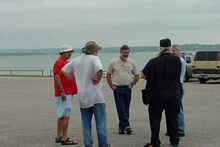 |
John Welsford on a visit to the states - Canyon
Lake |
John sends me drawings for the new boat, a very pretty 10 foot
sailing dinghy. “Pipkin, a very small wooden barrel, the
smallest medieval English barrel measure, is coming along nicely.
She’s 10 feet by four feet six inches, five planks to a
side. Fairly simple, single sail. I have to build one, so figured
that I’d build one I could have fun in.” A full set
of plans are to be included in the new edition. Pipkin is lovely
and graceful, so typically a Welsford boat.
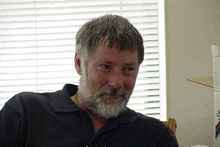 |
Also in the USA |
John sent me chapters. Beautiful accounts of rowing and sailing
New Zealand., the waters of Auckland and Tauranga,. So lovely
to sail with a friend, even if only in your mind, to see what
he saw, feel what he felt. Evocative writing, taking the reader
to a place, far, far away, a place seen through the writer’s
eyes. I could hear John, playing music on his flute with which
he always sails, music for the winds and waves and himself, improvisational
Celtic jazz, matching the sounds of nature and the waters he sailed.
Did I mention that JohnW writes science fiction as a hobby? Not
boating, science fiction, galaxies and worlds, centuries far,
far away. People and creatures far removed from the seas and sailing.
Ask him where the best bookstores are on several continents to
buy science fiction or boating books and he can tell you. “The
best science fiction second hand bookshop in the world is in Santa
Monica Beach, CA. The second best is on Lower Granville Street,
Vancouver, B.C., about 50 yards up on the right from the bridge.
The third best is on the third floor west of the Funan IT Mall
in Singapore.”
Gardening. I love and miss serious gardening. Oklahoma is unkind
to gardeners, too much heat, cold, rain, drought, hail, wind.
I am pulling out burned up plants from summer, cucumbers are running
rampart in the cypress trees. John’s gardens are tidy and
weeded, neatly planted and thinned. John gardens devoutly. “The
vegetable garden established last summer will do well this season.
We’re already eating from it, The cats love the catnip and
roll around completely shameless in it.” I start thinking
I not only want a Welsford boat, I want to move to New Zealand
where I can grow English style gardens with fresh peas and mint.
Cooking and food. We both love to cook, for ourselves and those
we love. John and I exchange endless notes on what we are cooking,
eating, thinking of eating or cooking. Proper breakfasts for John
when he sails and camps involve fresh eggs, rashers of bacon,
bread he baked himself. He has written a cookbook I discover,
no longer in print, for cooking outdoors, in boats and hiking.
No manufactured breakfast bars or Power Bars, but real food while
boating. I grow to like this man even more. We exchange more cooking
and gardening notes. He gives me his recipe for correctly baking
English scones, well New Zealand scones, actually. I locate candied
orange peels in Oklahoma to try them out. They are delicious.
“We do English scones on a regular basis, I think they
are a lot like your biscuits. One cup of flour, one teaspoon of
baking powder, one pinch of salt, one large dessert spoon of butter.
Sift the dry ingredients in, rub the butter in. It should give
you a slightly crumbly mix that will hold together compressed,
if not use more butter. When done you can put half a cup of sultanas
(raisins) or grated cheddar cheese. My favorite, which is Christmas
fruit cake peel mix, complete with glace’ cherries. Or just
plain. Mix to a stiff dough with milk and roll out to about 30
mm. (about one inch ) thick on a floured board, then cut into
three inch squares and bake for about 15 minutes at 180 degrees
Celsius (350 degrees Fahrenheit).”
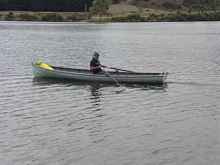 |
John rowing his Huff Boat. |
“The plain ones can be eaten with butter, raspberry jam
and whipped cream, drunk with English Breakfast or Ceylon tea,
which is your traditional Devonshire tea. The others, just lots
of butter. Eat while slightly warm and get them down before the
butter melts, so there is that contrasting texture and temperature.”
Food and proper food matters in New Zealand, it seems. JohnW
thinks if I cooked for the immigration officials they might perhaps
waive their stringent requirements for foreigners wanting to come
there. It seems I am not the only person wanting to sample New
Zealand’s food, mountains, sailing and boats.
Geography and weather, sailing conditions. I am reminded of how
different John’s world is. “I’m puttering around
on a really cold day trying to keep warm. It is a south easterly,
which in this part of the world is a reminder that Antarctica
is to the south of us. Today it feels as though it’s just
over the horizon. Blowing, raining and miserable, no heating in
my office yet.” I am sweltering in Oklahoma’s heat.
I start reading about New Zealand, the closest landmass to Antarctica.
Ice flows break away routinely and threaten their shipping lanes,
whales beach themselves and die by the hundreds during their migrations
between South Island and Antarctica. No native mammals before
modern man brought them except for a tiny mouse, a nation of birds
and trees unlike any I know, volcanoes and thermal pools, rocks
and bays, winds that whip suddenly and violently onto the water
at forty to seventy miles per hour. More clearly than ever I saw
the seaworthiness of the boats JohnW designed. They were designed
for the waters he lived and sailed in, conditions more difficult
than any we might encounter. Had I ever questioned their seaworthiness
? How could anyone?
John’s stories fueled my imagination, perhaps I could not
sail New Zealand , but certainly to venture far from the inland
waters I lived on. Suddenly a lake, no matter how large, seemed
small. Mike had long yearned to journey, to sail bigger waters.
He had built and owned a true blue water boat, a boat that never
sailed blue water. Now I too began to see what he had dreamed
of, but our visions had changed with age. Ten years ago Mike had
built the Boat Palace single-handed, a builder’s dream shop.
His vision? A building home for a river cruiser to leave Oklahoma,
travel the Mississippi River and navigable waters of America,
into the Gulf of Mexico, the Caribbean. Ultimately to go up the
eastern United States coast and into the Great Lakes. This voyage
would take no ordinary homebuilt boat. We had no plans, only a
dream. John Welsford was the answer to our dreams. He alone held
the plans for the boat.
We did not know it. John Welsford did not know it. Only the boat
knew.
Part Two continues more “Conversations
With John Welsford” and the boat finds us.
The Rendezvous, a thirty-three foot cruiser, to be built
for exploration of America.
Her name, “One True Thing”
*** |

